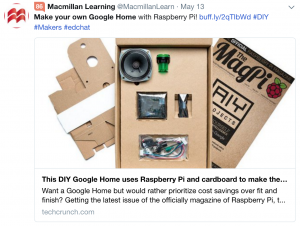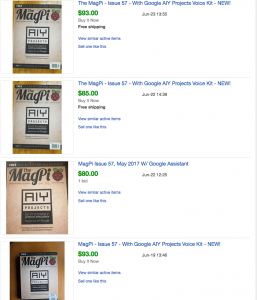
DIY Google Home
Last year, I partnered with Steve Youngblood to make an Amazon Alexa on a Raspberry Pi. In January of this year, I teamed up with Liz Simpson to provide a DIY Alexa workshop for high school ladies through ChickTech. Last month (May 2017), Google Home came out with their DIY version on a Raspberry Pi. Google did things a little differently than Amazon. Their intent was to make the project easier by offering a kit to complete the project. The kit was offered through MagPi, a magazine from the UK sold in bookstores and via subscriptions in the US. Specifically the kit was offered as a part of MagPi issue 57.

Since I was so invested in the Amazon Alexa project last year, I was more than intrigued to complete the DIY Google Home project. Unfortunately, I did not have a subscription to MagPi magazine. I contacted Liz Simpson and Steve Youngblood (my partners in crime) to start the DIY Google Home project. Liz drove to MicroCenter and Fry’s in an attempt to buy the kit. No luck. I started calling every Barnes & Noble in Atlanta (about 5) and the response was the same each time, “You’re the 6th person this morning to ask for that item. We sold out within hours of receiving the magazines. Good Luck!” Next, I checked eBay and found that the $7 magazine was being resold on eBay for 10 times the price!

There had to be another way to make a Google Home
Research
First, I dissected the project. The PDF version of the magazine was available online: https://www.raspberrypi.org/magpi-issues/MagPi57.pdf
The Magpi kit included a speaker, microphone, a button and a cardboard box. I decided the cardboard box was not essential to the functionality, so I mentally tossed it aside. I already had the speaker and microphone from the Alexa project, so all I needed was the button. I also noted that instead of saying, “Ok Google,” the user pressed a button before each command. The software was available for download for anyone (with a computer) and completely un-gated.
Multiple Methods to Victory
After my research phase, I realized that there were actually 2 ways to complete this project.
- Buy a button, or
- Find a version of the code that didn’t require a button
More Research
I took to Google (somewhat ironic) to find alternate versions of the project that didn’t require the kit. I also ordered a button on Amazon.
As I waited for the button to arrive, I continued researching. I found that Google already put out the code for the Google Home on their Google Developers site – https://developers.google.com/assistant/sdk/prototype/getting-started-pi-python/ The tricky part was that they named it Google Assistant instead of Google Home, so it didn’t come up in my search results. I actually found the SDK from a YouTube video by Don Hui (NovaSpiritTech), a hobbyist in New York. Don and I are now Twitter friends. Small World. But I digress.
I completed the project using Don’s instructions and the SDK from Google Developers and invited Liz to “hunt for Easter Eggs” with me.
Then my button arrived. I found a set of slightly modified instructions for using your own button instead of the MagPi kit button on Android Authority. http://www.androidauthority.com/build-google-assistant-raspberry-pi-770296/
Liz and I completed the MagPi Google Home project with the button.
But what about Steve Youngblood?
I told Steve (and Liz) that I wanted to compare our DIY Alexa to the DIY Google Home. Steve responded, “Yeah, let’s have a Raspberry Pi Bake-off!”
Thus we made the Raspberry Pi Bake-off video where we compared our DIY Alexa to the DIY Google Home.
Why are Amazon and Google releasing their code for their Artificial Intelligence (AI) devices?
Shouldn’t they just focus on selling their devices for $179 – $50? There are many reasons why Amazon and Google are releasing their code.
Spreading Adoption
AI devices are still very new. People are still figuring out what they are and what they do. This is a great PR story to say that their AI is available to the masses. The average Joe probably has about 5% interest in actually completing the project, and is 95% more likely to buy the device. 95% of the people who complete the project have some technical knowledge under their belt before they start. In the end, they get some great publicity and it helps them sell more devices.
Opportunities for developers outside of the US and UK
Apps and smart home integrations for Alexa and Google Home will be developed, but the devices are only sold in US, UK and a few other countries. Developers in other countries are making their own devices because they can’t actually buy the device. As of the writing of this post, the Amazon Echo is only sold in US, UK, and Germany (and perhaps a few other EU countries). Google Home is only sold in Australia, Canada, France, Germany, Japan, UK and US.
There is massive programming talent in India, China, and many other countries where these devices are not sold. Developers in other countries must make their own devices to test their development apps (aka Alexa Skills). Side Note: I’ve been personally contacted by at least 5 or more smart switch manufacturers in China to test out their Alexa enabled devices.
Putting AI into other devices
Once again it is about adoption and proliferation. The more widespread adoption you can get for your device, the better. Google and Amazon are hoping that appliance and other manufacturers will add their SDK into their devices. Amazon would love for auto manufacturers to put Alexa inside their cars, and it looks like Ford is the first one. At CES 2017, announcements were made around Alexa integration with Lenovo, Dish DVRs, and LG refrigerators.
Technically, I finished the DIY Google Home project twice. First with the SDK, and then subsequently with “the button.”
Let me know your thoughts:
- Have I piqued your interest into making your own Google Home? Or Amazon Alexa?
- Who will win, Amazon Alexa or Google Home?
- Are you more likely to buy the device or make it?








